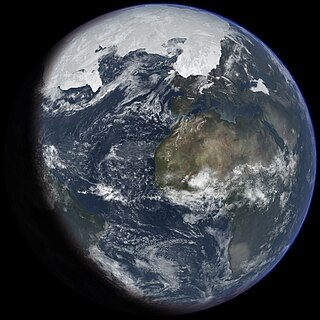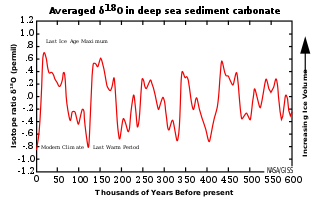
An ice age is a long period of reduction in the temperature of Earth's surface and atmosphere, resulting in the presence or expansion of continental and polar ice sheets and alpine glaciers. Earth's climate alternates between ice ages and greenhouse periods, during which there are no glaciers on the planet. Earth is currently in the Quaternary glaciation. Individual pulses of cold climate within an ice age are termed glacial periods, and intermittent warm periods within an ice age are called interglacials or interstadials.

The Pleistocene is the geological epoch that lasted from about 2,580,000 to 11,700 years ago, spanning the Earth's most recent period of repeated glaciations. Before a change was finally confirmed in 2009 by the International Union of Geological Sciences, the cutoff of the Pleistocene and the preceding Pliocene was regarded as being 1.806 million years Before Present (BP). Publications from earlier years may use either definition of the period. The end of the Pleistocene corresponds with the end of the last glacial period and also with the end of the Paleolithic age used in archaeology. The name is a combination of Ancient Greek πλεῖστος, pleīstos, 'most' and καινός, kainós, 'new'.

Milankovitch cycles describe the collective effects of changes in the Earth's movements on its climate over thousands of years. The term was coined and named after Serbian geophysicist and astronomer Milutin Milanković. In the 1920s, he hypothesized that variations in eccentricity, axial tilt, and precession combined to result in cyclical variations in the intra-annual and latitudinal distribution of solar radiation at the Earth's surface, and that this orbital forcing strongly influenced the Earth's climatic patterns.

Dansgaard–Oeschger events, named after palaeoclimatologists Willi Dansgaard and Hans Oeschger, are rapid climate fluctuations that occurred 25 times during the last glacial period. Some scientists say that the events occur quasi-periodically with a recurrence time being a multiple of 1,470 years, but this is debated. The comparable climate cyclicity during the Holocene is referred to as Bond events.

There have been five or six major ice ages in the history of Earth over the past 3 billion years. The Late Cenozoic Ice Age began 34 million years ago, its latest phase being the Quaternary glaciation, in progress since 2.58 million years ago.
The Cromerian Stage or Cromerian Complex, also called the Cromerian, is a stage in the Pleistocene glacial history of north-western Europe, mostly occurring more than half a million years ago. It is named after the East Anglian town of Cromer in Great Britain where interglacial deposits that accumulated during part of this stage were first discovered. The stratotype for this interglacial is the Cromer Forest Bed situated at the bottom of the coastal cliff near West Runton. The Cromerian stage preceded the Anglian and Elsterian glacials and show an absence of glacial deposits in western Europe, which led to the historical terms Cromerian interglacial and the Cromerian warm period. It is now known that the Cromerian consisted of multiple glacial and interglacial periods.
Orbital forcing is the effect on climate of slow changes in the tilt of the Earth's axis and shape of the Earth's orbit around the sun. These orbital changes modify the total amount of sunlight reaching the Earth by up to 25% at mid-latitudes. In this context, the term "forcing" signifies a physical process that affects the Earth's climate.
The European Project for Ice Coring in Antarctica (EPICA) is a multinational European project for deep ice core drilling in Antarctica. Its main objective is to obtain full documentation of the climatic and atmospheric record archived in Antarctic ice by drilling and analyzing two ice cores and comparing these with their Greenland counterparts. Evaluation of these records will provide information about the natural climate variability and mechanisms of rapid climatic changes during the last glacial epoch.
Stadials and interstadials are phases dividing the Quaternary period, or the last 2.6 million years. Stadials are periods of colder climate while interstadials are periods of warmer climate.

Marine isotope stages (MIS), marine oxygen-isotope stages, or oxygen isotope stages (OIS), are alternating warm and cool periods in the Earth's paleoclimate, deduced from oxygen isotope data reflecting changes in temperature derived from data from deep sea core samples. Working backwards from the present, which is MIS 1 in the scale, stages with even numbers have high levels of oxygen-18 and represent cold glacial periods, while the odd-numbered stages are lows in the oxygen-18 figures, representing warm interglacial intervals. The data are derived from pollen and foraminifera (plankton) remains in drilled marine sediment cores, sapropels, and other data that reflect historic climate; these are called proxies.

An interglacial period is a geological interval of warmer global average temperature lasting thousands of years that separates consecutive glacial periods within an ice age. The current Holocene interglacial began at the end of the Pleistocene, about 11,700 years ago.

The Quaternary glaciation, also known as the Pleistocene glaciation, is an alternating series of glacial and interglacial periods during the Quaternary period that began 2.58 Ma and is ongoing. Although geologists describe this entire period up to the present as an "ice age", in popular culture this term usually refers to the most recent glacial period, or to the Pleistocene epoch in general. Since Earth still has polar ice sheets, geologists consider the Quaternary glaciation to be ongoing, though currently in an interglacial period.

The 100,000-year problem of the Milankovitch theory of orbital forcing refers to a discrepancy between the reconstructed geologic temperature record and the reconstructed amount of incoming solar radiation, or insolation over the past 800,000 years. Due to variations in the Earth's orbit, the amount of insolation varies with periods of around 21,000, 40,000, 100,000, and 400,000 years. Variations in the amount of incident solar energy drive changes in the climate of the Earth, and are recognised as a key factor in the timing of initiation and termination of glaciations.

Marine Isotope Stage 11 or MIS 11 is a Marine Isotope Stage in the geologic temperature record, covering the interglacial period between 424,000 and 374,000 years ago. It corresponds to the Hoxnian Stage in Britain.
Gunz, Günz or Gunz Complex is a timespan in the glacial history of the Alps. It started approximately one million years ago and ended about 370 000 years ago. Some sources put the end at 480 000 years ago. Deep sea core samples have identified approximately 5 glacial cycles of varying intensity during Gunz.
Danube or Donau is a timespan in the glacial history of the Alps. Danube is currently regarded to have started approximately 1.8 million years ago, at the start of the Calabrian age of the international geochronology. It ended approximately one million years ago. Deep sea core samples have identified approximately 20 glacial cycles during Danube.
Biber or the Biber Complex is a timespan approximately 2.6–1.8 million years ago in the glacial history of the Alps. Biber corresponds to the Gelasian age in the international geochronology, which since 2009 is regarded as the first age of the Quaternary period. Deep sea core samples have identified approximately 20 glacial cycles of varying intensity during Biber.
The Gunz-Haslach interglacial and the Gunz-Haslach warm period (Günz-Haslach-Warmzeit) are historical terms for a hypothetical warm period of the Pleistocene in the Alpine region, between the Gunz and Haslach glaciations. The interglacial was defined as the erosion phase which follows the Günz and precedes the Haslach Glacial Stage. It thus corresponds to the stratigraphic gap between the Zeil gravels in Swabia and Haslach gravels northeast of the Rhine Glacier.
The Haslach-Mindel interglacial and the Haslach-Mindel warm period (Haslach-Mindel-Warmzeit) are historical terms for a hypothetical warm period of the Pleistocene in the Alpine region, between the Haslach and Mindel glacial stages. The interglacial was defined as the erosion phase which follows the Haslach and precedes the Mindel glacial stage. It thus corresponds to the stratigraphic gap between the Haslach beds and the Tannheim-Laupheim gravels northeast of the Rhine Glacier.

The Don Glaciation, also known as the Donian Glaciation and the Donian Stage, was the major glaciation of the East European Plain, 0.5–0.8 million years ago, during the Cromerian Stage of the Middle Pleistocene. It is correlated to Marine Isotope Stage 16, approximately 650,000 years ago, which globally contained one of the largest glacial volumes of the Quaternary.










